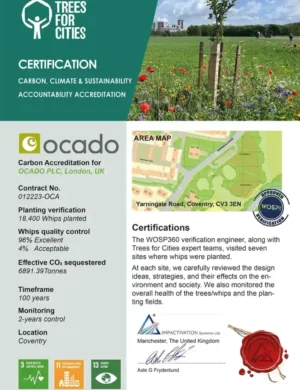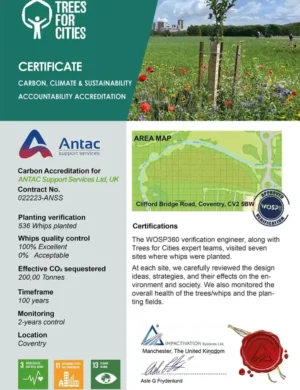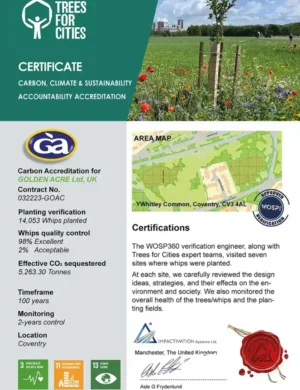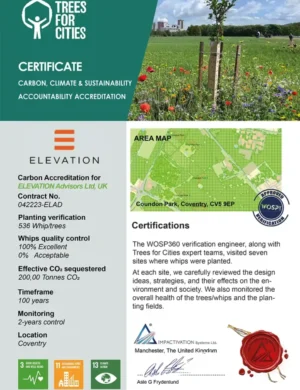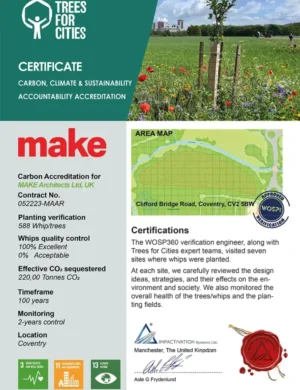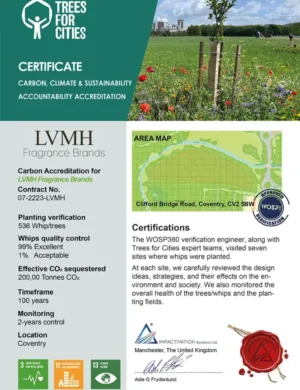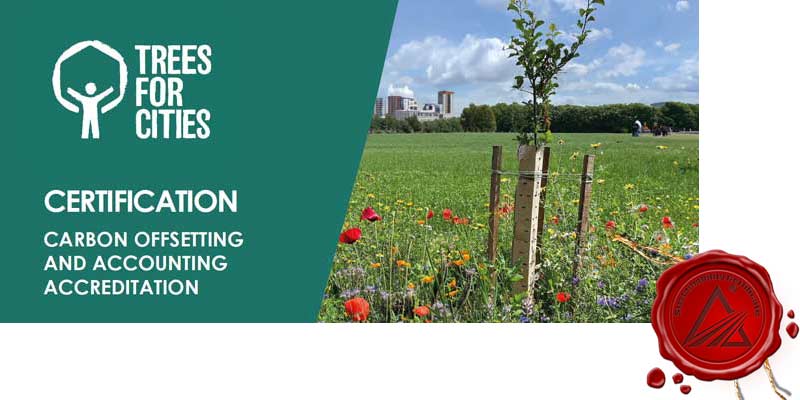
Certifications
The WOSP360 verification engineer, along with Trees for Cities expert teams, visited seven sites where whips were planted.
At each site, we carefully reviewed the design ideas, strategies, and their effects on the environment and society.
We also monitored the overall health of the trees/whips and the planting fields.
The environment is everything for a new tree.
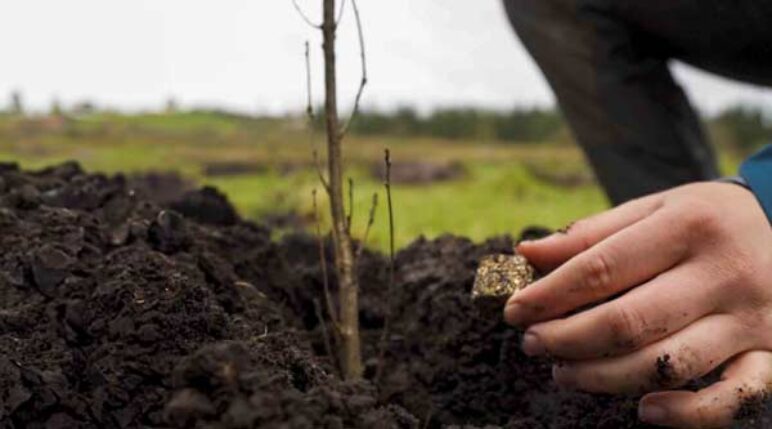
Grow healthy forests that survive the test of time.
Biodiversity matters
Up to 15 billion trees are cut down every year across the globe. And while trees are replanted, losses of 50%> have become more frequent during the past decade due to extreme weather events. The world cannot keep up with this loss of biodiversity.
When young saplings do not get the essential nutrients from underground fungal networks, mortality rates soar, they become susceptible to drought and soil-borne diseases, and with unsuitable soil conditions, growth rates plummet. And yet, there is a simple, overlooked solution: fungi.
Rejuvenating our soils
The environment is everything for a new tree. Soil type consideration and the localisation of species are essential in supporting saplings to adapt to their new home. We harness the power of locally adapted fungi by growing bespoke pellets to every site, ensuring the most suitable, nourishing conditions and enabling trees to survive for centuries.
And when are the odds of a tree’s survival greater? Reforestation success improves, and we put down the roots needed to grow a healthier planet.
Enhance tree planting success and effortlessly fit into your planting process, ensuring that new saplings flourish, build resilience to drought, and overcome the mortality rates often seen across the forestry industry.
What are Mycorrhizal fungi?
Every healthy forest ecosystem is infused with a wondrous, interconnected underground network of fungi. Known as mycorrhizal fungi, this potent group of organisms are vital to life on this planet, providing trees with the nutrients they need to survive – and thrive.
Found in the soil of almost all ecosystems on Earth, they form symbiotic relationships with 95% of all vascular plants, creating a flow of nutrients such as nitrogen and phosphorus and trace minerals such as potassium, calcium, copper, zinc and iron. In exchange, the fungi are nourished with photosynthesised carbohydrates from their host plant.
Every fungus comprises microscopic threads called hyphae – vast fungal threads that reach deep into the moisture reserves below the ground, acquiring nutrients 100,000 times more efficiently than tree roots and fortifying the soil’s ability to hold water.
This extraordinary underground exchange has become known as the Wood-Wide Web, nurturing the ecology of the soil and boosting its carbon storage potential in the process.
The Power of the Wood-Wide Web
As the only company using mycorrhizal fungi in forestry, we work with a unique subgroup called ectomycorrhizal fungi. We choose to grow this species as it forms the most advanced symbiotic associations of all fungal subgroups, doing so exclusively with trees in the beech, pine, willow, and lime tree families.
In natural woodlands, young saplings rely almost exclusively on these fungal nutrients to survive. But with the right conditions, tree growth rates can be improved, mortality rates of young saplings can be decreased, and greater resilience to tree-borne diseases and drought can be achieved.
When temperate and boreal forests cover around 25% of the Earth’s land surface, ectomycorrhizal fungal networks are critical to maintaining the health of our planet. But a future with more trees requires a future with more ectomycorrhizal fungi.
The scientifically designed Rhizopellets for this select list of species:
- Pine (Pinus sp.)
- Spruce (Picea sp.)
- Fir (Abies sp.)
- Larch (Larix sp.)
- Hemlock (Tsuga sp.)
- Douglas fir (Pseudotsuga sp.)
- Lime (Tilia sp.)
- Birch (Betula sp.)
- Hornbeam (Carpinus sp.)
- Oak (Quercus sp.)
- Beech (Fagus sp.)
- Chestnut (Castanea sp.)
- Alder (Alnus sp.)
- Hazel (Corylus sp.)
- Willow (Salix sp.)
- Poplar (Populus sp.)
- Aspen (Populus sp.)
